Breeding Horses in the Herd
Our personal experience of breeding horses in the herd situation is not extensive because we are not in this business, but the experiences we have had, and those of many of our breeder friends, have led us to the same conclusion: horses are herd animals and when they are given the responsibility to behave as they would in a wild situation, it is rare for them not to do so.
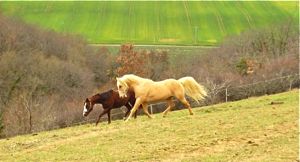
Examples of horse breeders who use a natural environment are our neighbour Susan Pfeifer at Rambos (this photo shows her Quarter-horse stallion running free), and Dogwood Sports Horses in the US - this article gives a beautiful account of a mare and stallion's interaction in a herd setting.
There are many differing opinions of how to manage breeding horses, and it is true that reproducing the scenario of a wild band in most domestic situations is not always possible. Often the reasons for this are based on a lack of understanding however, rather than what is actually best for the horses. Horses know how to look after each other better than we do as long as their instincts have not been too badly disturbed.
Horses Looking After Each Other In The Herd Environment:
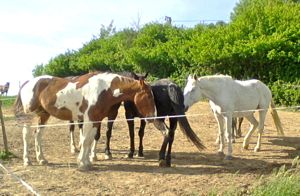
Swishing flies in the summer
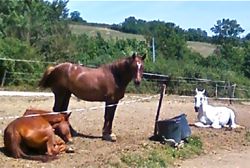
Standing guard while friends sleep
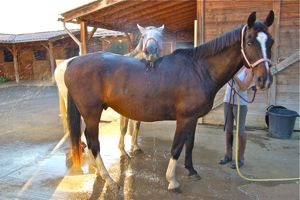
Giving reassurance
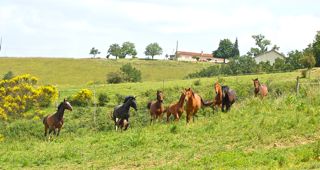
Communicating threat with the collective flight response
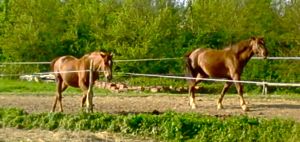
Friends accompany each other on journeys around the Paddock Paradise
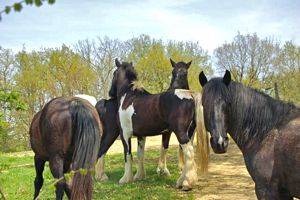
Mutual grooming between brother and sister Uno and Totale
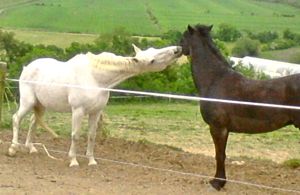
Play-fighting between gelding friends
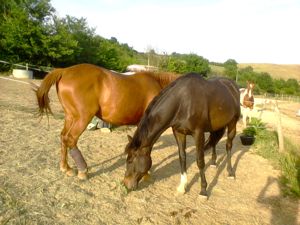
Moral support and companionship: Odette stands by her best friend hope when she is disabled with an injury
The Family Environment:
the best solution for weaning
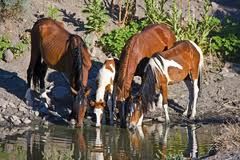
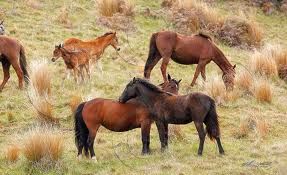
These photos show wild breeding horse bands, drinking and grooming and just being together.
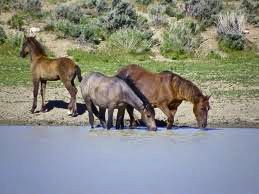
The photo below is our family herd. The fact that they may not be a
typical horse herd is immaterial, they are being as horses should be
allowed to be, secure in each others company and enjoying their lives.
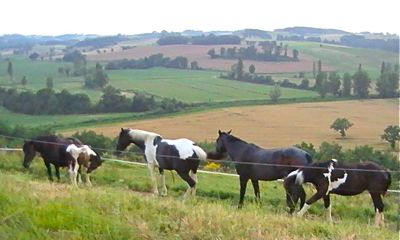
If we interfere and separate the older youngster in a forced weaning process, no matter how 'well arranged' the mare will be upset by the weaning experience, which will influence her unborn foal, and she will be on her own raising her baby.
We may worry that she becomes too drained physically by a foal at foot while she is pregnant, but if she is well fed and looked after, the emotional damage from the separation will have much greater consequences for her health. She will wean her present foal in her own way when her time has come and there will be no unnatural traumatisation which affects the youngsters outlook and relationship with people for the rest of their lives.
The following photos show a foal who was born with us, the year after his older sister who we had taken on the year before along with her mother. Instead of separating the yearling from her mother and newborn foal, we left them together, and a natural weaning process took place as a result. Not only was this totally un-traumatic for the yealing, but it meant that she was there to look after her younger brother, giving their mother a well-needed rest.
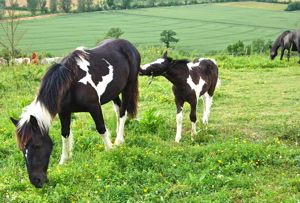
Big sister looks after little brother while mum (background, right) get a chance to graze in peace
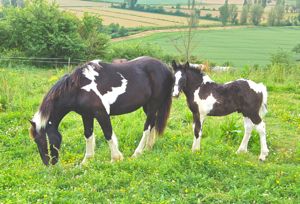
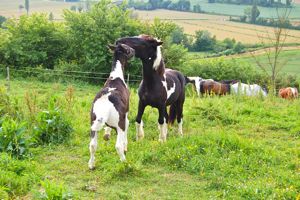
Interestingly, Totale, the older sister who was weaned naturally, has now grown into an incredibly confident adult, never worried about being taken from the herd and worked on her own. Unfortunately, although he did stay with his mother until he was a year old, we were unable to wean her younger brother naturally because we had to give the mare back to her owner. He has grown up to be a much more nervous character, and is much less happy to leave the herd than his sister. There is undoubtedly an element of innate temperament in this difference, but Uno's natural timidity only made the forced separation from his mother all the more difficult for him.
Our two warmblood youngsters who we bought from the stud at 6 months of age, and whose weaning we obviously had no control over, have such a naturally confident temperament that they handled this event and subsequent change of home without excessive negative consequences, although their subsequent integration into our main herd will undoubtedly have gone a long way to healing any wounds from this separation.
If breeding horses was not such a commercial enterprise in many cases, we could easily avoid stress and trauma that often has a lifelong influence on horses, simply by allowing things to proceed more naturally, and in their own time.
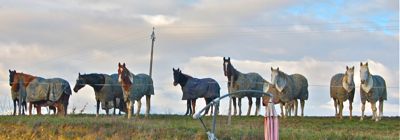
Return from Breeding Horses in the Herd to the Happy Horse Training homepage
The pages on HHT are so wide-ranging and interrelated that we strongly recommend you look at the site plan to find other subjects that may interest you.
New from HHT!
AudioRide is a series of exercises designed to listen to while you ride.
Audio descriptions guide you through each step of developing a balanced, dynamic connection with the horse through your position.
This truly innovative learning tool gives you a whole new way of being guided in your riding, in a calm, clear, step-by-step way.
Free Download! Introductory Exercise: Riding in the Now
The Gymnastic Rider eBook
Now available exclusively from HHT!
A unique, comprehensive guide to practical rider biomechanics. This professionally produced eBook takes the rider through the process of developing their body in the specific way that brings the horse's movement into harmony and balance, without force and constraint. Click here for full details, and to download the 15-page introduction to the book for free.
Join the Happy Horse Training group on Facebook!
See and share topical info, news and photo's, and take part in lively discussions.
Click here to go to the HHT group (make sure you log into fb first) and then click on the 'join' button at the top of the page.
Join the Whole Horse Newsletter!
HHT's free monthly newsletter giving you wide-ranging and intelligent insights into holistic horsemanship.
Just enter your details below to join.
Free bonus on the riding position with all new subscriptions: Ten Top Tips To Instantly Improve Your Connection With Your Horse.
Click here to see back issues of The Whole Horse newsletter
Train Your Horse
The Holistic Way
How To Train A Horse Without Force
is a unique guide to training horses through energetic connection and
gymnastic training. Part 1 covers everything on the ground, from
handling to the lungeing technique that develops strength, straightness
and engagement. Comes with a free eBook supplement on Horse Trauma.
Click here for more details.
"As a student of Zen Buddhism for nearly three decades, I've often wondered when someone was going to write the book on Zen and the art of horsemanship, and I think that your emphasis on mindfulness and energy connection gets right at the heart of the matter."
- Prof. Teresa Lloyd, U.S.
Do You Have
A Horse Story
To Share On HHT?
So many people have been through
wonderful experiences with horses, whether in training or otherwise. If
you've made a change in a horse's life - or one has made a change in
yours - tell us about it here.
Learn The Natural Barefoot Trim - The Simple Way
The Simple Seven-Step Natural Trim is a comprehensive step-by-step guide to a cutting-edge barefoot trim. Click here to find out more.
What people say about HHT:
"The riding instruction is outstanding, if instructors in the UK taught this way there would be a lot of happy riders and horses."
"The riding tuition exceeded my hopes and expectations by a long way; giving me an exciting new facet to horsemanship which is lighter. more subtle, more elegant and more meaningful. It is as if a new door has opened bringing more sunlight and air."
"My goodness - what a change has taken place in my riding. I think that I'm starting to sit 'into' the horse rather than on top of him. I felt my horse's movements in a way that has almost never happened before"
Click on Testimonials for more





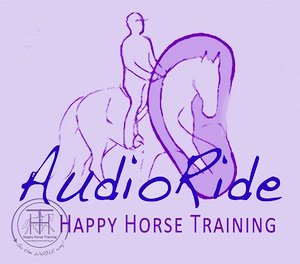




New! Comments
Anything to say about this page? Leave your comment in the box below.